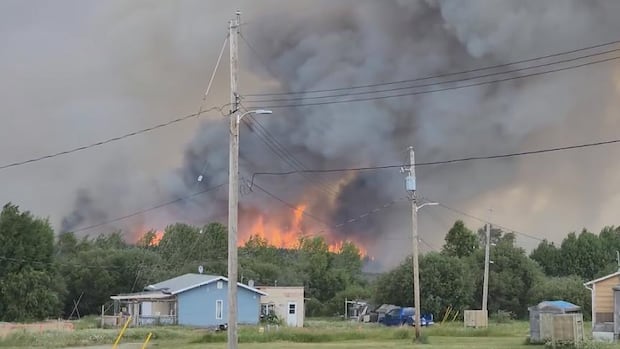Poor air quality expected to persist beyond long weekend in northwestern Ontario
High ridge of pressure over province trapping pollutants, says meteorologist

Most of the province remains under air quality statements due to wildfire smoke from northern Ontario and the Prairies.
Environment and Climate Change Canada (ECCC) issued the alerts on Sunday, which extend across the northwest. More severe air quality warnings have been issued for several First Nations in the region, including:
- Pickle Lake — Cat Lake.
- Pikangikum — Poplar Hill — MacDowell.
- Sandy Lake — Weagamow Lake — Deer Lake.
Monica Vaswani, a warning preparedness meteorologist with ECCC, told CBC News on Sunday that there is a high ridge of pressure over much of the province, which is making it difficult for clean air to come through.
"Unfortunately, what it does is it traps the pollutants and kind of makes them linger. There's a good chance we're going to continue to see these statements and in other communities, even warnings, through to at least Tuesday," Vaswani said. "Likely by Wednesday, there should be an improvement."
Common symptoms of poor air quality include eye, nose and throat irritation, headaches or a mild cough. Those most at risk include children, older adults, pregnant people, those with underlying health conditions, and people who work outdoors.
One of the challenges in trying to prepare for poor air conditions is how quickly air quality can fluctuate, especially as wildfires are constantly evolving, Vaswani explained.
Furthermore, "as the weather changes, the wind direction changes, and that can really determine exactly where that poor air goes," she said.
People at higher risk of experiencing symptoms are encouraged to consider wearing an N95 mask outdoors and to use an air filter indoors to protect themselves from pollutants, Vaswani said.
Ontario Forest Fires says the wildland fire hazard remains high throughout much of the region, with areas of extreme hazard in the western parts of the Kenora and Red Lake fire management areas.
The Thunder Bay, Nipigon and Sioux Lookout sectors are seeing high to moderate hazards, it says.
As of Sunday afternoon, there were 54 wildfires burning across northern Ontario. Of these, nine are considered not under control.
Tracking long-term health effects
Stephanie Charles is a health promoter in environmental health at the Northwestern Health Unit (NWHU), based in Kenora. She said it's hard to gauge the cumulative effects of ongoing air quality alerts on people's health.
"We are able to look at epidemiological data, like you could see hospital admissions for those usually with pre-existing conditions — the COPD (chronic obstructive pulmonary disease), asthma, cardiovascular disease — and then you could overlay that with smoke events and smoke advisories," Charles told CBC's Up North.
"The tricky thing about that is it's often lagging, so it's definitely an emerging science."

While Thunder Bay and Winnipeg each have an air quality monitoring station, there are no such stations in areas in between, Charles said.
To help bridge the gap, the NWHU has been working with ECCC and the University of Northern British Columbia to install particulate matter (PM2.5) air quality sensors in half a dozen locations in the region.
"That also will help them to enhance their data they have on ground conditions for air quality, and hopefully lead to some better imaging or data management," said Charles.
In the meantime, she said it's important for people to do their best to keep their homes insulated from the smoke outside.
"Take it easy, don't overdo it, and just be mindful of the health symptoms," she said.
People can check the province's interactive forest fire map online for the latest information on wildfires closest to them.


